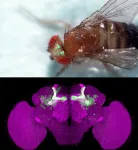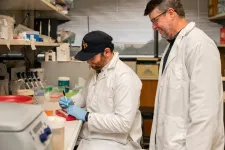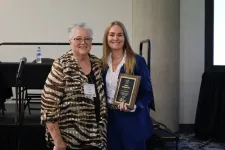(Press-News.org) Lugano, Switzerland, 17 October 2023 – Women living and working in places with higher levels of fine particle air pollution are more likely to get breast cancer than those living and working in less polluted areas. Results of the first study to take account of the effects of both residential and workplace exposure to air pollution on breast cancer risk are presented at the ESMO Congress 2023 in Madrid, Spain (1).
“Our data showed a statistically significant association between long term exposure to fine particle air pollution, at home and at work, and risk of breast cancer. This contrasts with previous research which looked only at fine particle exposure where women were living, and showed small or no effects on breast cancer risk,” said Professor Béatrice Fervers, Head of Prevention Cancer Environment Department, Léon Bérard Comprehensive Cancer Centre, France.
In the study, home and workplace exposure to pollution in 2419 women with breast cancer was compared to that in 2984 women without breast cancer over the period 1990-2011. The results showed that breast cancer risk increased by 28% when exposure to fine particle (PM2.5) air pollution increased by 10 µg/m3 – approximately equivalent to the difference
inPM2.5 particle concentration typically seen in rural versus urban areas of Europe. Smaller increases in breast cancer risk were also recorded in women exposed to high levels of larger particle air pollution (PM10 and nitrogen dioxide). Fervers and colleagues now plan to investigate the effects of pollution exposure during commuting to get a complete picture of effects on breast cancer risk.
Professor Charles Swanton, the Francis Crick Institute, London, UK, whose research suggesting how PM2.5 particles may trigger lung cancer in non-smokers was presented at ESMO Congress 2022 (2), stressed the importance of the new findings with breast cancer.
“These very small particles can penetrate deep into the lung and get into the bloodstream from where they are absorbed into breast and other tissues. There is already evidence that air pollutants can change the architecture of the breast (3,4). It will be important to test if pollutants allow cells in breast tissue with pre-existing mutations to expand and drive tumour promotion possibly through inflammatory processes, similar to our observations in non-smokers with lung cancer,” he said. “It is very concerning that small pollutant particles in the air and indeed microplastic particles of similar size are getting into the environment when we don’t yet understand their potential to promote cancer. There is an urgent need to set up laboratory studies to investigate the effects of these small air pollutant particles on the latency, grade, aggression and progression of breast tumours,” he added.
“There is now strong epidemiological and biological evidence for the link between PM2.5 particle exposure and cancer, and there are good clinical and economic reasons for reducing pollution in order to prevent cancers,” said Professor Jean-Yves Blay, ESMO Director of Public Policy.
Following on a proposal from the European Commission in October 2022 to reduce the limit for PM2.5 particles in the air from the current 25 µg/m3 to 10 µg/m3 by 2030, ESMO urged a reduction in the PM2.5 limit still further to 5 µg/m3, in line with the World Health Organisation’s air quality guidance (5). “Reducing PM2.5 particles in the air to the WHO recommended level is critical because of their association with a variety of tumour types, including breast cancer,” Blay added. “We have a responsibility to push for this change, not only for people in Europe but worldwide where there are big variations in the pollution landscape.” The lower limit was indeed adopted by the European Parliament’s Environment, Public Health and Food Safety Committee in June 2023.
More recently, in September 2023, the European Parliament adopted in plenary session its report on the ongoing revision of the EU Ambient Air Quality Directives, which reflects ESMO’s recommendations to set the annual limit value for Fine Particulate Matter (PM2.5) at 5 µg/m³. This adoption opens interinstitutional negotiations between the co-legislators – European Parliament, European Commission and EU Council – to agree on the final text of the directive. (6,7)
“By supporting our requests with solid scientific evidence, we are offering a new dimension to health public policy. The work is not over, and change will not happen overnight, but we are moving in the right direction,” the ESMO Public Policy Director concluded.
-END-
Notes to Editors
Please make sure to use the official name of the meeting in your reports: ESMO Congress 2023
Official Congress Hashtag: #ESMO23. Follow it to stay up to date and use it to take part in the conversation on X (Twitter), LinkedIn, Instagram, Facebook
Disclaimer
This press release contains information provided by the author of the highlighted abstract and reflects the content of this abstract. It does not necessarily reflect the views or opinions of ESMO who cannot be held responsible for the accuracy of the data. Commentators quoted in the press release are required to comply with the ESMO Declaration of Interests policy and the ESMO Code of Conduct.
References
1 Fervers B et al. Longterm residential and workplace exposure to air pollution and breast cancer risk: A case-control study nested in the French E3N cohort from 1990 to 2011 will be presented by Fervers B. during the Mini Oral Session on Monday, 23 October 2023, 16:30-18:00 CEST, at ESMO Congress 2023, Madrid (Bilbao Auditorium).
2 Swanton C et al. Mechanism of action and an actionable inflammatory axis for air pollution induced non-small cell lung cancer: Towards molecular cancer prevention. Presented at ESMO Congress 2022, Paris, France Presidential Symposium 1, LBA1
3 Niehoff NM et al. Outdoor air pollution and terminal duct lobular involution of the normal breast. Breast Cancer Res 2020; 22,100.
4Kotake R et al. An association between mammographic breast density and fine particulate matter among postmenopausal women. Environ Sci Pollut Res Int. 2023 Feb;30(10):25953-25958.
5 WHO global air quality guidelines: particulate matter (PM2.5 and PM10), ozone, nitrogen dioxide, sulfur dioxide and carbon monoxide. https://www.who.int/publications/i/item/9789240034228
6 European Parliament. Revision of the ambient air quality directives. https://www.europarl.europa.eu/legislative-train/theme-a-european-green-deal/file-revision-of-eu-ambient-air-quality-legislation
7 European Parliament. Towards cleaner air for Europe. https://www.europarl.europa.eu/RegData/etudes/ATAG/2023/751388/EPRS_ATA(2023)751388_EN.pdf
About the European Society for Medical Oncology (ESMO)
Representing more than 33,000 oncology professionals from 170 countries worldwide, ESMO is a reference for oncology education and information. Driven by a shared determination to secure the best possible outcomes for patients, ESMO is committed to standing by those who care about cancer through addressing the diverse needs of #ONEoncologycommunity, offering #educationforLIFE, and advocating for #accessiblecancerCARE. www.esmo.org
238MO
LONGTERM RESIDENTIAL AND WORKPLACE EXPOSURE TO AIR POLLUTION AND BREAST CANCER RISK: A CASE-CONTROL STUDY NESTED IN THE FRENCH E3N COHORT FROM 1990 TO 2011
B. Fervers1, M. Duboeuf1, A. Amadou1, T. Coudon1, L. Grassot1, E. Faure2, G. Severi3, F. Mancini3, P. Salizzoni4, J. Gulliver5, D. Praud1 [Text Wrapping Break]1Cancer And Environment Department, Centre Léon Bérard, Lyon/FRANCE, 2Exposome, Hérédité, Cancer Et Santé, Gustave Roussy, Villejuif/FRANCE, 3Exposome, Hérédité, Cancer Et Santé Inserm 1018, Gustave Roussy, Villejuif/FRANCE, 4Mécanique Des Fluides, Ecole Centrale, Ecully/FRANCE, 5Centre For Environmental Health And Sustainability, University of Leicester, Leicester/UNITED KINGDOM
Background: Air pollution, classified as carcinogenic to humans, is a major public health concern. Studies on breast cancer are scarce and remain inconsistent. We studied the association between breast cancer risk and long-term exposure to particulate matters (PM2.5, PM10) and nitrogen dioxide (NO2) estimated at the womens' residential and workplace addresses. Methods: We conducted a case-control study of 2419 cases and 2984 individually matched controls nested in the French prospective E3N cohort, over the period 1990-2011. Controls were matched to cases on department of residence, age (±1 year); date (±3 months), and menopausal status at blood collection. Annual mean PM2.5, PM10 and NO2 concentration levels were estimated using a Land Use Regression (LUR) model (resolution 50m x 50m) and were assigned to women based on their geocoded residential and workplace addresses. The mean exposure was calculated for each woman from their inclusion into the E3N cohort to their index date (date of diagnosis of cases). Odds ratios (OR) and 95% confidence intervals (CI) were estimated using multivariate logistic regression models, for a 10 µg/m3 increase in PM2.5, PM10 and NO2. Adjustment variables were selected from the literature, using a directed acyclic graph. Results: The results showed a statistically significant linear increase in breast cancer risk related to mean exposure to PM2.5 (adjusted OR 1.28; CI 1.00–1.63, for an increment of 10 µg/m3). A numerically increased risk was observed for PM10 (adjusted OR1.09; CI 0.92–1.30) and NO2 (adjusted OR 1.05; CI 0.97–1.13) for an increment of 10 µg/m3. No effect modification by menopausal status was observed (p interaction 0.99, 0.90, and 0.86 respectively for PM2.5PM10 and NO2). Analyses by hormone receptor status showed a positive but not significant association for PM2.5 for oestrogen receptor positive (ER+) breast cancer cases (adjusted OR 1.32; CI 0.97–1.79). Conclusions: To our knowledge, this study is the first to investigate breast cancer risk associated with long term air pollution exposure at both, the subjects’ residence and workplace, estimated using a very fine spatial resolution LUR model. Future studies should consider exposure during commuting.
Legal entity responsible for the study: INSERM
Funding: Foundation or academic group WITHOUT funding from a pharma, biotech, or other commercial company[Text Wrapping Break]- ARC Foundation for Cancer Research (CANCAIR201601245), ANSES, French League against Cancer, Fondation de France
Disclosure: All authors have declared no conflicts of interest.
END
Air pollution and breast cancer risk - a link that calls for political action
2023-10-17
ELSE PRESS RELEASES FROM THIS DATE:
Thermosensation is critical for the survival of animals, but the mechanisms by which this is modulated by nutritional status remain unclear
2023-10-17
Thermosensation is critical for the survival of animals, but the mechanisms by which this is modulated by nutritional status remain unclear; here, behavioral and live brain imaging studies reveal why food-sated fruit flies prefer to stay at relatively higher temperatures compared to hungry flies.
#####
In your coverage, please use this URL to provide access to the freely available paper in PLOS Biology: http://journals.plos.org/plosbiology/article?id=10.1371/journal.pbio.3002332
Article Title: Independent insulin signaling modulators govern hot avoidance ...
Multi-drug resistant strain of E.coli battles bacteria in healthy gut
2023-10-17
Different strains of E.coli can outcompete one another to take over the gut, a new study reveals.
Publishing their findings today in PLOS Biology, scientists reveal that a particular strain, known as MDR ST131, can readily colonise new hosts, even if those hosts are already have E.coli in their healthy gut.
The international team, led by experts at the University of Birmingham, used a mouse model to help understand why strains of E.coli that live in a healthy gut are rapidly overtaken of when challenged with a multi-drug resistant strain.
Lead author Professor Alan McNally, from ...
Sleep and stress give clues to understanding epileptic seizures - study
2023-10-17
Sleeping patterns and stress hormones could be the key to understanding how and when people with epilepsy are likely to experience seizures, a new study reveals.
Researchers used mathematical modelling to understand the impact of different physiological processes, such as sleep and changes in concentration of the stress-hormone cortisol, on key signatures of epilepsy – known as epileptiform discharges (ED).
Epilepsy is a serious neurological disorder characterised by a tendency to have recurrent, spontaneous seizures. Classically, seizures were assumed to occur at random, until the discovery of ED activity with timescales that vary from hours and days through to months.
The scientists ...
The Dompé Foundation launches 16 scholarships for neuroscience and neurobiology students in the US
2023-10-17
The Dompé Foundation is offering 16 scholarships to support neuroscience and neurobiology students enrolled at US universities for the academic year 2023/2024. This funding opportunity, which honors the legacy of the only female Italian Nobel laureate in Medicine, is intended for promising candidates from any nationality that have already been admitted to a Master’s, PhD or post-doc program. With a total budget of up to about 1 million USD, the Foundation has doubled from the previous two years its funding for the US project, ...
NASA September 2023 temperature data shows continued record warming
2023-10-17
Continuing the temperature trend from this summer, September 2023 was the hottest September on record, according to scientists at NASA’s Goddard Institute for Space Studies (GISS). The month also set the record for the highest temperature anomaly – the largest difference from the long-term average.
This visualization shows global temperature anomalies along with the underlying seasonal cycle. Temperatures advance from January through December left to right, rising during warmer months and falling during cooler months. The color of each line represents the year, with colder purples for the 1960s and warmer oranges and yellows for more recent ...
Researchers test seafloor fiber optic cable as an earthquake early warning system
2023-10-17
One of the biggest challenges for earthquake early warning systems (EEW) is the lack of seismic stations located offshore of heavily populated coastlines, where some of the world’s most seismically active regions are located. In a new study published in The Seismic Record, researchers show how unused telecommunications fiber optic cable can be transformed for offshore EEW.
Jiuxun Yin, a Caltech researcher now at SLB, and colleagues used 50 kilometers of a submarine telecom cable running between the United States and Chile, sampling ...
Researchers receive NIH grant to improve quality of life for people with Down syndrome
2023-10-17
A team of researchers at the Texas A&M University School of Veterinary Medicine & Biomedical Sciences (VMBS) has received a grant from the National Institutes of Health (NIH) to research metabolism in people with Down syndrome.
By targeting genes that affect metabolism, the team may be able to develop drug therapies for physical and mental symptoms of the condition, like muscle loss, accelerated aging, and lower cognitive function, thereby improving the quality of life for people with Down syndrome.
The new grant will also make Dr. Weston Porter, a professor in the VMBS Department of Veterinary Physiology & Pharmacology and lead researcher ...
Miniaturized FSO breakthrough unlocks high-speed wireless communication anywhere
2023-10-17
In a world that relies on high-speed internet and seamless communication, the absence of a reliable fiber connection can be a significant hurdle. Fortunately, a cutting-edge technology known as free-space optical communication (FSO) offers a flexible solution for field-deployable high-speed wireless communication in areas where fiber connections are unavailable.
FSO has garnered attention for its versatility across various scales of operation. On a global level, it plays a crucial role in establishing high-speed satellite internet projects like Starlink, ensuring global connectivity. At the ground level, ...
Pennington Biomedical’s Dr. Leanne Redman selected for top honor by The Obesity Society
2023-10-17
BATON ROUGE – The Obesity Society – the leading professional society focused on obesity science, treatment and prevention – has named Pennington Biomedical’s Dr. Leanne Redman as the recipient of the 2023 TOPS Research Achievement Award. The award, which is funded by the Take Off Pounds Sensibly, or TOPS, Foundation, was presented to Dr. Redman on Monday, Oct. 16, in recognition of her contributions to research in the field of obesity.
Considered by many to be the top award for obesity research, Dr. ...
New technique helps robots pack objects into a tight space
2023-10-17
CAMBRIDGE, Mass. -- Anyone who has ever tried to pack a family-sized amount of luggage into a sedan-sized trunk knows this is a hard problem. Robots struggle with dense packing tasks, too.
For the robot, solving the packing problem involves satisfying many constraints, such as stacking luggage so suitcases don’t topple out of the trunk, heavy objects aren’t placed on top of lighter ones, and collisions between the robotic arm and the car’s bumper are avoided.
Some traditional methods tackle this problem sequentially, guessing a partial solution ...





